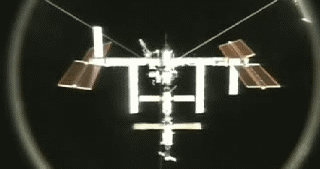 Where's Saturn? Is that a UFO--or the ISS? What's the name of that star? Get the answers from mySKY--a fun new astronomy helper from Meade. Where's Saturn? Is that a UFO--or the ISS? What's the name of that star? Get the answers from mySKY--a fun new astronomy helper from Meade. HEAVENLY TRIANGLE: Tonight, sometime after sunset, step outside and look south. Clouds permitting, you'll see a bright triangle in the sky with the Moon, Jupiter and red giant star Antares as vertices. It's nothing special, just very pretty: sky map. MARS ROVER UPDATE: NASA has heard from Mars rover Opportunity, and the report is promising. On July 23rd, Opportunity's power levels had improved slightly as a result of several days of energy-conserving silence and low activity. The rover is struggling to survive a severe dust storm which has darkened the sky, reducing sunlight to the rover's solar panels by as much as 99 percent: 
Above: Darkening skies over Meridiani Planum. [More]
Meanwhile on the other side of Mars, weekend communications from Spirit indicated that the sky had cleared slightly, improving power levels for Spirit as well. "The outlook for both Opportunity and Spirit depends on the weather, which makes it unpredictable," says JPL's John Callas, project manager for both rovers. "If the weather holds where it is now or gets better, the rovers will be OK. If it gets worse, the situation becomes more complex." VERMICIOUS MYSTERY: The video below has generated much speculation about the origin of the "space station worm." Best responses so far: "After carefully checking my washer and dryer, I'm sure it's one of my socks," suggests one reader. The Buck family wonders, "could it be a Vermicious Knid?" No. The worm is almost certainly something from the ISS or Atlantis shaken loose at undocking. But what? Another reader points out that "NASA doesn't know either." SPACE STATION WORM: What flies through space and wriggles like a worm? Before you answer, take a look at this movie of the International Space Station (ISS): 
Click to view a longer movie: wmv, mpg, avi.
The footage comes from space shuttle Atlantis, which was flying around the ISS on June 19th after undocking. Cameras on the shuttle recorded not only the behemoth space station, but also a strange wriggling object moving in front of the station's solar panels and radiators. What is it? Veteran satellite observer John Locker of Wirral, England, who intercepted NASA's Ku band satellite TV link as the two spacecraft orbited over the UK and thus recorded a full-length movie of the object, calls it the "space station worm." At first he thought it might be an item lost by a spacewalking astronaut. "It looks a lot like the strap hanging down from Steven Swanson's waist," he points out: image. But the worm seems much too big for that. Another possibility is ice. Space journalist Jim McDade notes that "pieces of ice have been flying off spacecraft since the Mercury days. Don't forget John Glenn's fireflys. Ice tends to dance and roll as it sublimates in the microgravity, near vacuum of space." For instance, a ring of ice dislodged from the shuttle's thruster nozzles, bent and tumbling, might produce a semblance of wriggling. One thing we're sure it's not: a real worm. Ideas are welcomed.
.2007 Noctilucent Cloud Gallery
[Night-Sky Cameras] ["Noctilucent Cloud"--the song] | 
